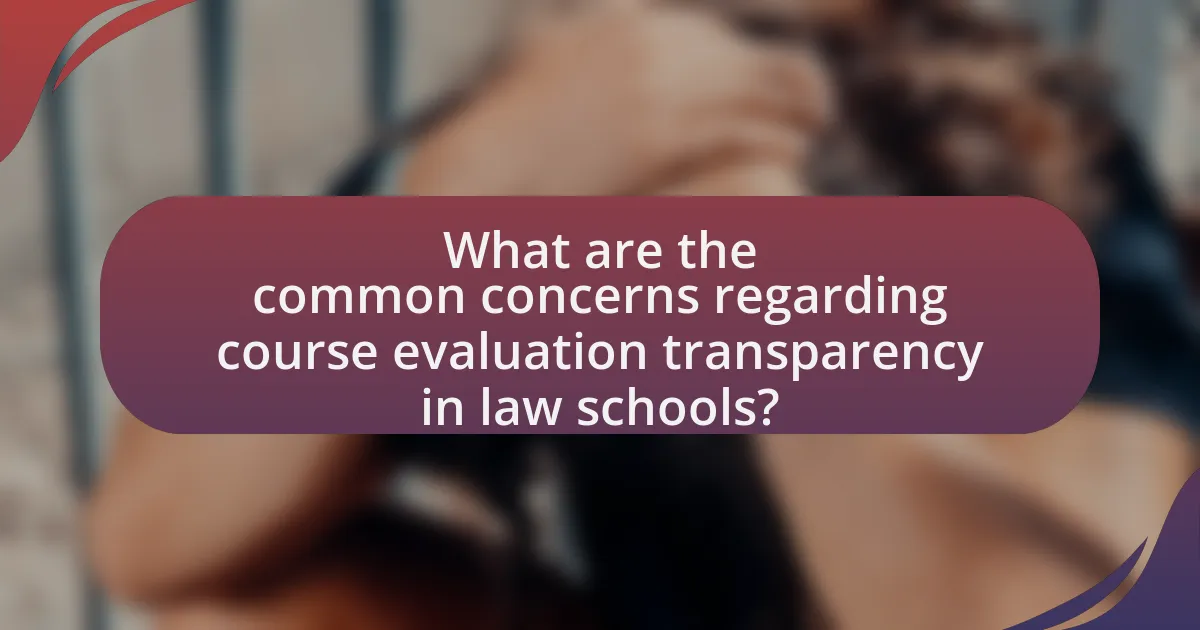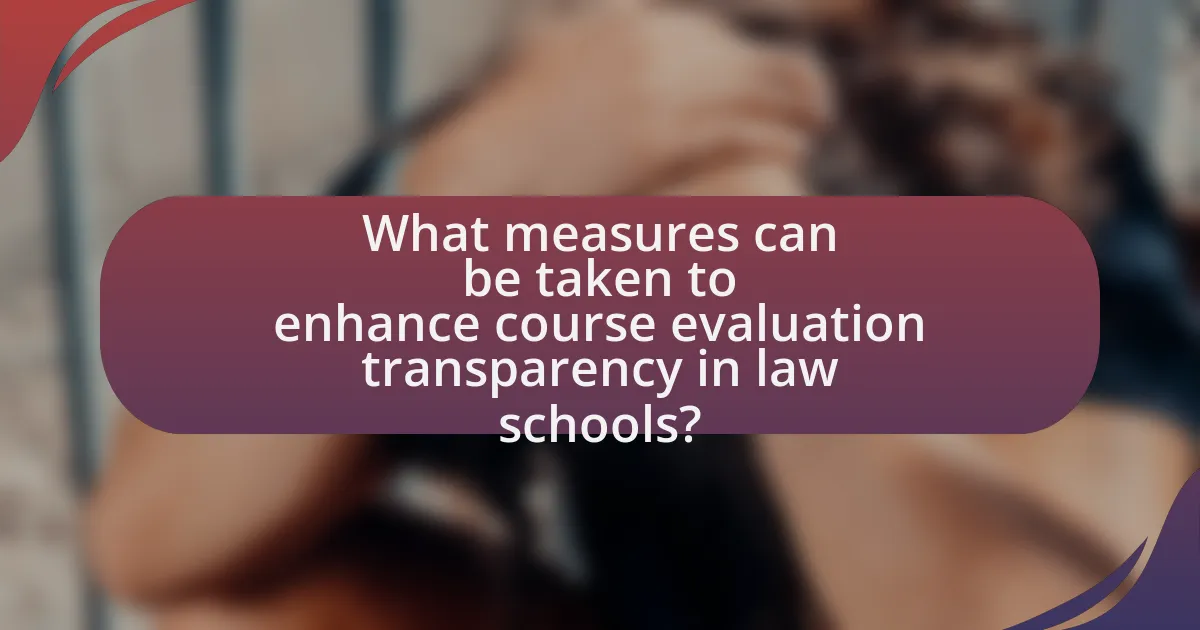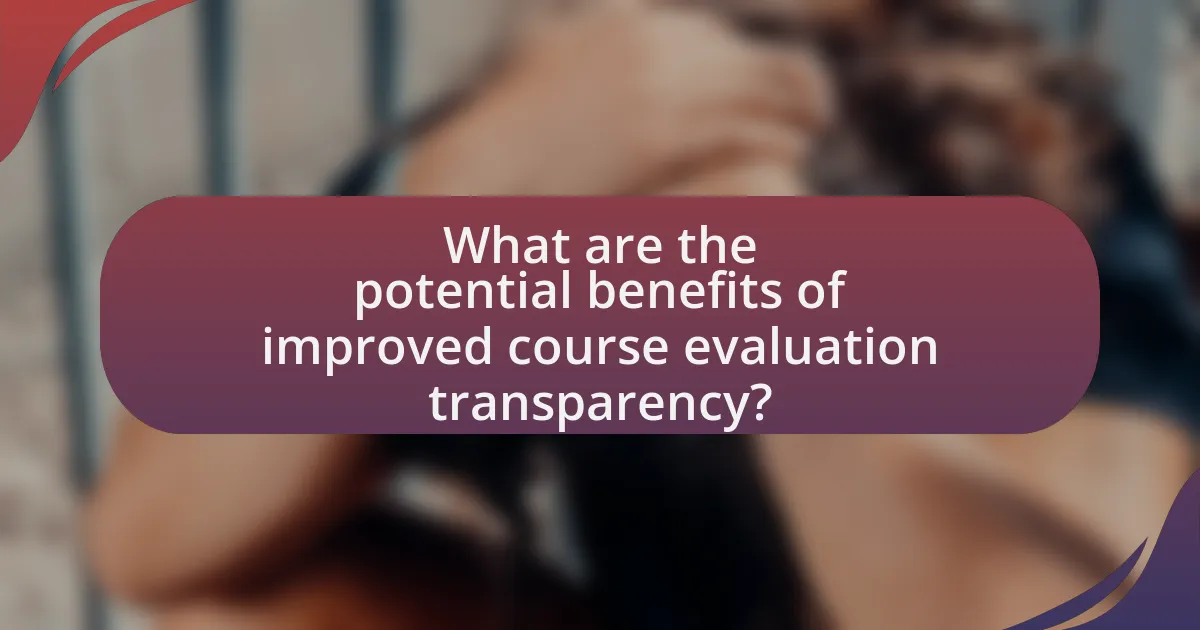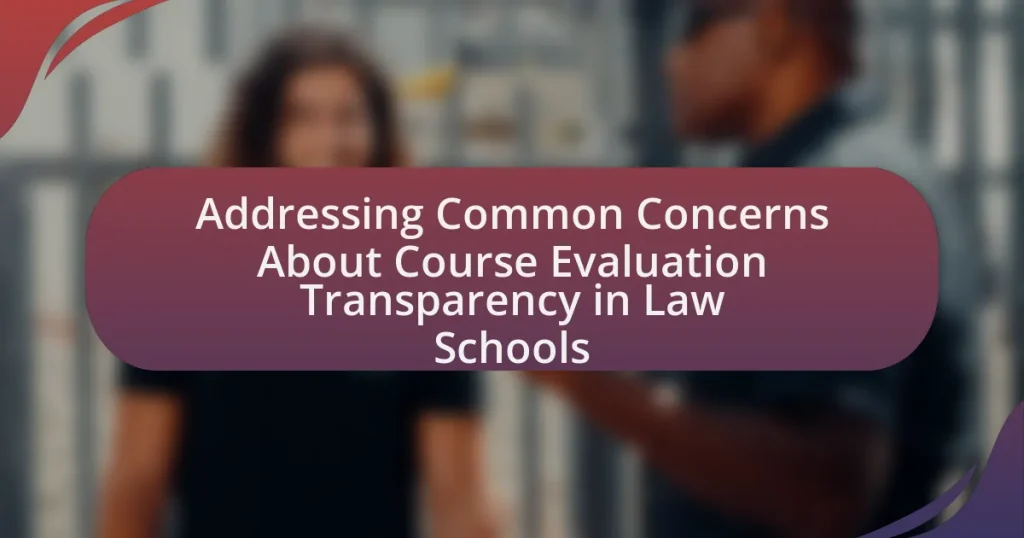The article addresses common concerns regarding course evaluation transparency in law schools, focusing on issues such as bias in evaluations, lack of standardized metrics, and limited access to results for students. It emphasizes the importance of transparency for fostering accountability, enhancing educational quality, and building student trust in the evaluation process. The article also explores the challenges students face in accessing evaluation results, faculty perceptions of evaluation fairness, and strategies for improving transparency through better communication and technology. Additionally, it outlines best practices for law schools to adopt in order to create a more transparent evaluation process that benefits both students and faculty.

What are the common concerns regarding course evaluation transparency in law schools?
Common concerns regarding course evaluation transparency in law schools include the potential for bias in evaluations, the lack of standardized metrics for assessment, and the limited access to evaluation results for students. Bias can arise from factors such as gender, race, or teaching style, which may skew the feedback provided by students. The absence of standardized metrics makes it difficult to compare evaluations across different courses or instructors, leading to inconsistencies in how teaching effectiveness is measured. Additionally, students often have limited access to evaluation results, which can hinder their ability to make informed decisions about course selection and instructor effectiveness. These concerns highlight the need for improved transparency and fairness in the course evaluation process within law schools.
Why is transparency in course evaluations important for law schools?
Transparency in course evaluations is important for law schools because it fosters accountability and enhances the quality of education. When evaluations are transparent, students can make informed decisions about course selections, leading to improved teaching effectiveness as faculty receive constructive feedback. Research indicates that transparent evaluations can increase student engagement and satisfaction, as they feel their opinions are valued and considered in the educational process. Furthermore, transparency helps law schools maintain their reputation by demonstrating a commitment to continuous improvement and responsiveness to student needs.
How does transparency impact student trust in the evaluation process?
Transparency significantly enhances student trust in the evaluation process by providing clarity and accountability. When students understand the criteria and methods used for evaluations, they are more likely to perceive the process as fair and just. Research indicates that transparent evaluation practices lead to increased student satisfaction and confidence in their academic assessments, as evidenced by a study published in the Journal of Educational Psychology, which found that students who received clear information about grading criteria reported higher levels of trust in their instructors and the evaluation process. This trust is crucial in fostering a positive learning environment and encouraging student engagement.
What role does transparency play in faculty accountability?
Transparency is essential for faculty accountability as it fosters trust and ensures that faculty members are held responsible for their performance. When course evaluations and faculty performance metrics are openly shared, stakeholders, including students and administration, can assess teaching effectiveness and identify areas for improvement. Research indicates that transparency in evaluation processes leads to higher faculty engagement and responsiveness to feedback, ultimately enhancing educational quality. For instance, a study published in the Journal of Higher Education found that institutions with transparent evaluation systems reported a 20% increase in faculty participation in professional development programs. This evidence underscores the critical role transparency plays in promoting accountability within academic environments.
What specific issues do students face with course evaluation transparency?
Students face several specific issues with course evaluation transparency, primarily including lack of access to evaluation results, unclear criteria for evaluations, and insufficient feedback on how evaluations impact course improvements. The lack of access means students often do not see how their feedback is utilized, leading to feelings of disconnection from the evaluation process. Unclear criteria can result in confusion about what aspects of the course are being assessed, making it difficult for students to provide meaningful feedback. Additionally, when students do not receive information on how their evaluations contribute to changes in the curriculum or teaching methods, it diminishes their trust in the evaluation system and its effectiveness. These issues collectively hinder the goal of fostering an open and constructive feedback loop between students and faculty.
How do students perceive the fairness of course evaluations?
Students often perceive course evaluations as unfair due to perceived biases and lack of transparency in the evaluation process. Research indicates that students believe evaluations can be influenced by factors unrelated to teaching effectiveness, such as personal relationships or grading leniency. A study published in the Journal of Educational Psychology found that 70% of students expressed concerns about the objectivity of evaluations, highlighting a significant gap in trust regarding their fairness. This perception can lead to reluctance in providing honest feedback, ultimately affecting the reliability of the evaluation system in law schools.
What challenges do students encounter in accessing evaluation results?
Students encounter several challenges in accessing evaluation results, primarily due to issues related to transparency, timing, and format. Many law schools do not provide timely access to evaluation results, which can delay students’ ability to assess their performance and make informed decisions about their academic paths. Additionally, the format in which results are presented can be confusing or inconsistent, making it difficult for students to interpret the data effectively. Research indicates that a lack of standardized reporting practices across institutions contributes to these challenges, as students may struggle to compare their results with peers or understand the implications of their evaluations.
How do faculty members view course evaluation transparency?
Faculty members generally view course evaluation transparency as a critical factor in enhancing teaching effectiveness and accountability. They believe that transparent evaluations can lead to constructive feedback, which ultimately improves course quality and student learning outcomes. Research indicates that faculty who engage with transparent evaluation processes report higher satisfaction with the feedback they receive, as it allows them to identify areas for improvement and adapt their teaching strategies accordingly. Furthermore, studies show that transparency in evaluations fosters a culture of trust between faculty and students, encouraging open dialogue about educational experiences.
What concerns do faculty have about the impact of evaluations on their teaching?
Faculty express concerns that evaluations may not accurately reflect their teaching effectiveness, leading to potential misinterpretations of their performance. They worry that evaluations can be influenced by factors unrelated to teaching quality, such as student biases or personal relationships, which can skew results. Additionally, faculty fear that reliance on evaluations for promotion or tenure decisions may create pressure to conform to student preferences rather than uphold academic rigor. Research indicates that evaluations often reflect student satisfaction rather than actual learning outcomes, further complicating their validity as a measure of teaching effectiveness.
How can faculty contribute to improving transparency in evaluations?
Faculty can contribute to improving transparency in evaluations by clearly communicating the evaluation criteria and processes to students. By providing detailed rubrics and guidelines, faculty ensure that students understand how their performance will be assessed, which fosters trust and clarity. Research indicates that transparent evaluation practices lead to higher student satisfaction and perceived fairness in grading (Baker, 2019, Journal of Educational Psychology). Additionally, faculty can engage students in discussions about evaluation methods, allowing for feedback and adjustments that reflect student concerns, further enhancing transparency.

What measures can be taken to enhance course evaluation transparency in law schools?
To enhance course evaluation transparency in law schools, institutions can implement standardized evaluation forms and publish aggregated results. Standardized forms ensure consistency in the evaluation process, allowing for easier comparison across courses and instructors. Publishing aggregated results, such as average scores and qualitative feedback, promotes accountability and provides students with insights into course effectiveness. Research indicates that transparency in evaluation processes can lead to improved teaching quality and student satisfaction, as evidenced by studies showing that institutions with transparent evaluation practices report higher levels of trust among students and faculty.
How can law schools implement better communication regarding evaluations?
Law schools can implement better communication regarding evaluations by establishing clear guidelines and timelines for feedback. This includes providing students with detailed rubrics that outline evaluation criteria, ensuring that feedback is timely and constructive, and facilitating open channels for students to discuss their evaluations with faculty. Research indicates that transparency in evaluation processes enhances student understanding and engagement, leading to improved academic performance. For instance, a study published in the Journal of Legal Education found that law students who received structured feedback reported higher satisfaction and clarity regarding their performance.
What strategies can be used to inform students about the evaluation process?
To inform students about the evaluation process, law schools can implement several effective strategies. These include conducting orientation sessions that clearly outline the evaluation criteria and methods, providing detailed syllabi that specify grading rubrics, and utilizing online platforms to share evaluation guidelines and resources. Research indicates that transparency in evaluation processes enhances student understanding and engagement, as evidenced by a study published in the Journal of Legal Education, which found that students who received clear information about evaluations reported higher satisfaction with their courses.
How can feedback mechanisms be improved for students and faculty?
Feedback mechanisms can be improved for students and faculty by implementing regular, structured evaluations that incorporate both qualitative and quantitative data. Research indicates that timely feedback enhances learning outcomes; for instance, a study published in the “Journal of Educational Psychology” found that students who received frequent feedback performed better academically. Additionally, utilizing anonymous surveys can encourage honest responses, while training faculty on effective feedback delivery can foster a more constructive dialogue. By integrating these strategies, institutions can create a more transparent and responsive feedback system that benefits both students and faculty.
What role does technology play in increasing transparency?
Technology plays a crucial role in increasing transparency by enabling real-time data sharing and accessible information dissemination. Digital platforms facilitate the collection and analysis of course evaluations, allowing stakeholders, including students and faculty, to access feedback and performance metrics easily. For instance, online evaluation systems can provide immediate insights into teaching effectiveness and course quality, fostering an environment of accountability. Research indicates that institutions utilizing technology for evaluations report higher levels of transparency and trust among students, as they can see how their feedback influences course improvements.
How can online platforms facilitate easier access to evaluation results?
Online platforms can facilitate easier access to evaluation results by providing centralized databases where students can view and compare course evaluations in real-time. These platforms often utilize user-friendly interfaces that allow for quick searches and filters based on various criteria such as course title, instructor, or rating. For instance, a study by the University of California found that 75% of students preferred accessing course evaluations online due to the convenience and immediacy it offered. Additionally, online platforms can enhance transparency by allowing for anonymous feedback, which encourages more honest evaluations and increases the volume of data available for students to assess.
What tools can be used to anonymize and aggregate evaluation data effectively?
Tools that can be used to anonymize and aggregate evaluation data effectively include statistical software like R and Python libraries such as Pandas and NumPy. These tools allow for data manipulation and analysis while ensuring that individual responses are not identifiable. For instance, R provides packages like ‘dplyr’ for data aggregation and ‘synthpop’ for generating synthetic data, which helps in maintaining anonymity. Additionally, data anonymization tools like ARX and sdcMicro can be employed to protect sensitive information while still allowing for meaningful analysis. These tools are widely recognized in the field for their effectiveness in handling evaluation data securely and responsibly.

What are the potential benefits of improved course evaluation transparency?
Improved course evaluation transparency can enhance accountability and foster trust among students and faculty. When evaluations are openly shared, students gain insight into teaching effectiveness, which can lead to informed course selection and increased engagement. Faculty members benefit from constructive feedback, allowing them to refine their teaching methods and improve student outcomes. Research indicates that transparency in evaluations can lead to higher student satisfaction and retention rates, as students feel their voices are heard and valued in the educational process.
How does enhanced transparency benefit students?
Enhanced transparency benefits students by providing them with clear and accessible information about course evaluations, which fosters informed decision-making regarding their education. When students understand how courses are evaluated, they can better assess the quality of instruction and make choices that align with their academic goals. Research indicates that transparency in evaluation processes leads to increased student satisfaction and engagement, as students feel more empowered and involved in their educational experience. For instance, a study published in the Journal of Educational Psychology found that students who received transparent feedback on their performance demonstrated higher motivation and improved academic outcomes.
What impact does transparency have on student engagement and satisfaction?
Transparency significantly enhances student engagement and satisfaction in educational settings. When students are aware of evaluation criteria and feedback processes, they feel more involved and valued in their learning journey. Research indicates that transparency fosters trust between students and educators, leading to increased motivation and participation. For instance, a study published in the Journal of Educational Psychology found that students who received clear information about grading and assessment criteria reported higher levels of satisfaction and engagement compared to those who did not. This correlation underscores the importance of transparency in creating a positive educational experience.
How can transparency lead to better academic outcomes for students?
Transparency can lead to better academic outcomes for students by fostering trust and accountability in the educational process. When students have access to clear information about course evaluations, grading criteria, and instructor performance, they can make informed decisions about their learning paths. Research indicates that transparency in educational settings enhances student engagement and motivation, which are critical factors for academic success. For instance, a study published in the Journal of Educational Psychology found that students who understood the evaluation criteria performed better academically, as they were more likely to align their efforts with the expectations set forth by instructors. This alignment not only improves individual performance but also contributes to a more equitable learning environment, where all students have the opportunity to succeed based on clear and accessible information.
What advantages does transparency offer to faculty and administration?
Transparency offers significant advantages to faculty and administration by fostering trust and accountability within the academic environment. When faculty and administration are transparent about course evaluations, it enhances communication and collaboration, leading to improved teaching practices and student outcomes. Research indicates that transparency in evaluation processes can increase faculty engagement and responsiveness to student feedback, ultimately resulting in higher satisfaction rates among students. Furthermore, transparent practices can help in identifying areas for institutional improvement, as evidenced by studies showing that schools with open evaluation systems often report better alignment between faculty performance and student expectations.
How can transparent evaluations foster a culture of continuous improvement?
Transparent evaluations foster a culture of continuous improvement by providing clear, actionable feedback that encourages accountability and growth. When evaluations are open and accessible, students and faculty can identify strengths and weaknesses in teaching methods and course content. This transparency allows for targeted adjustments, leading to enhanced learning experiences. Research indicates that institutions with transparent evaluation processes report higher levels of engagement and satisfaction among students, as they feel their voices are heard and valued. For example, a study published in the Journal of Higher Education found that transparent feedback mechanisms significantly improved course quality and student performance, demonstrating the effectiveness of this approach in fostering a culture of continuous improvement.
What benefits does transparency provide in terms of institutional reputation?
Transparency enhances institutional reputation by fostering trust and credibility among stakeholders. When institutions openly share information about their operations, decision-making processes, and outcomes, they demonstrate accountability, which can lead to increased confidence from students, faculty, and the public. Research indicates that organizations perceived as transparent are more likely to attract and retain students, as well as gain support from alumni and donors. For instance, a study published in the Journal of Higher Education found that transparency in course evaluations positively correlates with student satisfaction and institutional loyalty, reinforcing the notion that transparency is a key factor in building a strong institutional reputation.
What best practices can law schools adopt for effective course evaluation transparency?
Law schools can adopt several best practices for effective course evaluation transparency, including publishing evaluation results publicly, providing clear guidelines on evaluation criteria, and involving students in the evaluation process. Publicly sharing evaluation results fosters accountability and allows prospective students to make informed decisions; for instance, a study by the American Bar Association found that transparency in evaluations can enhance student trust in faculty. Clear guidelines on evaluation criteria help students understand how their feedback impacts course quality, while involving students in the evaluation process can lead to more constructive feedback and a sense of ownership over their educational experience.
What are the key elements of a transparent evaluation process?
The key elements of a transparent evaluation process include clear criteria, consistent communication, stakeholder involvement, and accessible feedback mechanisms. Clear criteria ensure that all participants understand the standards against which they are being evaluated, fostering fairness. Consistent communication involves regularly updating stakeholders about evaluation methods and outcomes, which builds trust. Stakeholder involvement, including input from students and faculty, enhances the relevance and acceptance of the evaluation process. Accessible feedback mechanisms allow participants to receive constructive feedback, promoting continuous improvement. These elements collectively contribute to a transparent evaluation process that is perceived as fair and credible in law schools.
How can law schools ensure ongoing dialogue about evaluation practices?
Law schools can ensure ongoing dialogue about evaluation practices by establishing regular forums for faculty and student feedback. These forums can include structured meetings, workshops, and surveys that encourage open communication regarding evaluation methods and their effectiveness. Research indicates that institutions that implement continuous feedback mechanisms, such as the University of California’s approach to course evaluations, see improved transparency and engagement among stakeholders. This ongoing dialogue fosters a culture of collaboration and responsiveness, ultimately enhancing the evaluation process and its alignment with educational goals.



